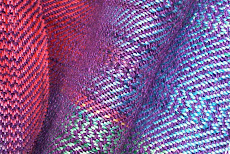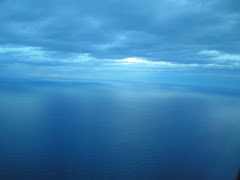I have had many a sundry adventure with the Black Welsh Mountain, but I did do the carded sample of Black Welsh Mountain so I started to spin the Teeswater, but before I get there... because I will do a skein evaluation up to this point.... May I please introduce.... Curly, the Pygora Goat... One of the Resident kids of my friend, Leslie.

Curly is the curious guy with her head coming through the fence (pix by Leslie)
Leslie sent me part of Curly's spring clip to cheer me up, because I was feeling down over the Black Welsh Mountain results (not bad, just not what I needed). So Curly's Clip caught the first plane south and arrived on Friday. It was not until today that I had time to bathe the little girl.
Here is a little information on the origins of the Pygora goat from the Pygora Breeder's Association
"The idea of cross-breeding the Pygmy and Angora began on the Navajo Reservation in Arizona. There, Katharine Jorgensen, an Oregon school teacher and experienced fiber craftsperson, saw colored Angora goats. She reports in a 1986 magazine article, “I thought: ‘wouldn’t it be wonderful to have a goat that produced mohair the color of the blue-grey grizzle Pygmy goats?’ I wanted to try and create a mohair-type goat and the traits that were best from both breeds” (Precious Fibers Magazine, Jan., 1986, p. 14-15). By the early 1980s, five years of line breeding an Angora doe to an unrelated Pygora buck finally resulted in the beautiful grey-grizzled goat Katharine dreamed of. The potential for champagne and honey browns was also present because of the Pygmy’s color genetics. By 1986, fleeces were often 5 inches long, had nice crimp and appeared in pure white, silver and grey. Today, Pygora colors reflect the full range of the Pygmy Color Registry and diverse fiber types contain many varied characteristics." -- end quote

Here is Curly about to have her little locks shorn. I personally think Leslie is a very brave person. She bought mega-expensive shears and with very little training sheared all her little crew by herself. She waited for another mutual friend,Charlene, to come visit and hold their heads so she could finish the necks.

Here we have Curly in the background and her sibling Larry in the foreground (what do you suppose the third one is named?).
Onwards to bath time. :)

First of all I spread little Curly's fleece out on the table to look at it.

Here is a close up of the fleece laid out.

This is a lovely lock I found prior to starting to scour Curly's fleece. It is really lovely and there are more of them. I am not a pygora fleece grader, but there is the silky guardhair, the long lock, the mohair like look... I think we have a grade A fleece type. But I have no experience here and I am only going by what I have read on the internet. Most of the locks are shorter, but I don't have the entire clip so I can't say definitively one way or the other, but Curly is a great little Goat so I'm giving her an 'A'.
This link goes to an interesting page that helps provide understanding of the various grades of Pygora fleece, Pygora Fiber Types, Pygora Breeder's Assoc. .
Now a good pair of shears will cost you... a bundle of money... and I know a beginning shearer interested in fleece quality might pay a $350 plus for a decent pair of shears.
Shearing is not for the faint of heart and definitely for the steady of hand. It is important to shear animals so they don't overheat, get sick, become trapped in a felted fleece. For the most part fleece animals have had the natural ability to roo (shed) bred out of them. A responsible shepherd will shear or have her flocks shorn. Each fleecy critter is different. Pygoras need to be shorn twice a year. This is Curly's spring clip. Almost every fleece will have a second cut in it. Some will have more and they should be discarded as they are not useful (however, I'm saving mine to try and do something creative... lol, tbd). With all due deference to my fabulous friend Leslie, I searched for a second cut so I could show people what it looks like. Here it is (and no criticizing the shearer, who is doing it herself, by herself with minimal training... a certain amount of on the job training is required of the shearer. I Hope I get to try shearing one day. :)

This is the second cut. The shears cut a into the fleece a bit and not close enough to the skin of the animal. The shearer went back and cut the fleece closer to the skin. This produced a 'second cut', the part between the skin and the fleece proper. Throw them away when you see them. Some will come out with picking, some with washing, and processing. Don't spin them. Throw them away.
Time to get the bath water ready. The key to good washing technique is basically two things. 1. consistent HOT water 2. NO Agitation
Some people like to use washing machines, I don't. I am not good enough, I don't have the right washer, and I'm a hands-on kind of person. I also just can't stand the risk of ruining a fleece on which I am either emotionally attached (like Curly) or that I have invested money in the purchase. I'd love to use my bathtub... think of the time saving! However, I have a very fastidious daughter and she objects to 'fleece' touching the bathtub so I use my sink. There are lots of people that do this especially fiber folk living in apartments, small houses, or those of us with no studios. Sinks are a wonderful invention.
First I clean it so there is no kitchen grease or food particles that can contaminate my fleece. Next I get my tools and utensils ready for use. Rubber gloves to keep my skin from being scalded, an apron to keep me from smelling too much like fleece, a colandar, tongs, my tea kettle, my soap, old towels, my drying area ready.

In this picture I have partially filled the sink with very very hot water from the tap and I am adding boiling water to bring up the temperature. I must have rubber gloves or I will scald my hand. REALLY HOT water is key to cleaning your fleece. Actually boiling fleece will yield felt so don't do that. Adding boiling water to a slightly cooler bath is a good idea. It should be so hot you can't put your naked hand in it. Use rubber gloves.

I add the soap to the wash after I add all the water, because I don't want suds. I swirl the water to mix the soap. I use 'Joy'. 'Dawn' is great too or 'Orvis'. Be careful not to use soap that is blue or green as this can actually dye your fiber in an odd cast.

At long last I put in some of Curly's locks to scour. I will gently press them under the water and leave them alone. Trust to the process! Do not move them in any way. The Soapy Water will do its work. I promise!

One bath will not be enough for any fleece. This is bath water number one. Absolutely and completely blech! Hot water, soap, and NO agitation.

If you are using your sink and draining water down the drain... make sure and put a strainer in. You will save yourself a HUGE plumbing bill later. And do you really want to explain why there is sheep wool in your drain to the plumber?
As you move on and are washing an entire fleece you will develop a rhythmn to your washing and you will develop a way to economize on your water usage.
It depends on the fleece and the state of the water in the bath after usage, but I generally follow a rhythm like this:
wash 1 discard
wash 2 discard
wash 3 (can be used for the batch 2 for wash 1) then discard
rinse 1 (can be used for batch 2 wash 2) then discard
rinse 2 (can be used for batch 2 wash 3) then discard
Rinses are always fresh water, but are re-used for washing.
This is a system that works for me. I can even work in a third batch by rotating out batches to a waiting bowl to wait for an appropriate turn in the bath.
By Rotating baths and batches of fleece you can economize on water usage and move the fleece through scouring in a more time efficient manner.

Here is Curly's fleece after one bath. Time for Bath 2.

This is the water after Bath 2. A huge difference from bath 1.

Here is Curly's fleece after 3 baths and 2 rinses.
Note that I am using a colander for my fleece. This is another very controlled method of putting fleece in and out of the bath water. Using a colander is very useful to help preserve lock structure.
Using a colander you can place specific locks in order and use the colander in and out of baths. It minimizes rubber glove contact with hot water. The best thing in place of the colander is to use the sifting cat boxes to wash fleece. Everything is flat and you move tray by tray into and out of the baths. I don't have those and I'm a little short of cash right now. However, here is a link if you'd like to purchase a set: Sifting Litter Pan .

Well, time to put Curly's first batch of locks out to dry. For comparison I put a few unwashed locks next to the drying ones. BIG difference! Someone recently said they liked to spin in the grease... I just think that spinning clean Curly beats the heck out of spinning the dirty version.

Curly first batch of fleece is dry and ready to take over and prepare for spinning. That will be another post. ;)
Have a good day all. This one was a marathon post!




















































